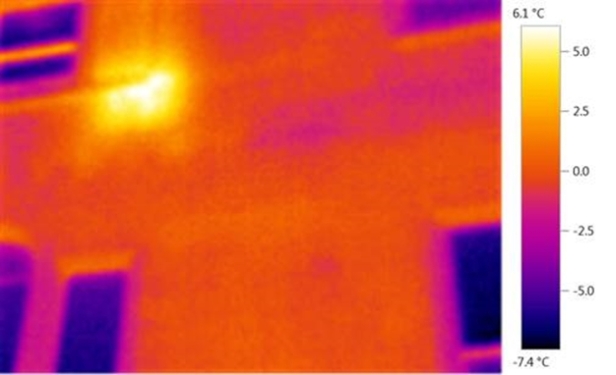Summary
It is estimated that by installing £3 of radiator reflector on a radiator on a solid walled house that perhaps £4 in gas can be saved each year. So for a typical house with 5 radiators attached to outside walls this saving could be £20 per year. For better insulated wall constructions the savings are likely to be less.
Background
It has become apparent through thermal imaging of homes in Bath that heat from radiators is being lost through the walls on older, typically solid walled homes in Bath. An example is shown below:

In the image which was taken from the outside of this Georgian property you can see the location of the radiator and the heat it is producing is leaking through the wall. The common solution to this problem is to insert a radiator reflector behind the radiator so heat is reflected back into the room reducing energy consumption. In the example of this house other radiators had been treated with reflectors and this was the only radiator left untreated and the only one where heat could been seen leaking through the outside wall of the house.
Radflek radiator reflector
Radflek is one of a number of companies which manufacture radiator reflectors of differing designs, and while not endorsing this particular product it is the only company which appears to provide scientific evidence of the performance of its product in the form of a BRE report: http://www.radflek.com/downloads/Radflek_FinalReport.pdf . and a BBA report: http://www.radflek.com/downloads/BBA-Radflek-Report.pdf
The Radflek reflector is formed from a sheet of plastic coated reflective aluminium which is attached to a clip and dropped onto the radiator hanger behind the radiator – a process which should take less than 2 minutes. Promotional material for the product can be found here: http://www.radflek.com/
Analysis of BRE Report
The BRE report details an experiment using a ‘hot box’ which empirically analyses the performance of the radaitor reflectors 2 example walls with differing thermal conductivities. the table below takes the BRE data and does some further calculations in order to work out what the annual saving is:
| Wall Description | Insulated Cavity Walls | Post 83 Cavity Walls | 76-82 Cavity Walls | Pre 76 cavity walls | Uninsulated solid walls | Comment |
|---|---|---|---|---|---|---|
| U Value W/m2/K | 0.42 | 0.69 | 1 | 1.44 | 2.1 | From Table 10 |
| Saving kWh/m2/yr | 19 | 31.2 | 45.2 | 65.1 | 94.9 | From Table 10 |
| Saving on gas kWh/m2/yr | 24 | 40 | 58 | 83 | 122 | Calc 1 |
| Average saving per radiator £/year | £0.80 | £1.32 | £1.91 | £2.75 | £4.02 | Calc 2 |
| Payback (years) | 3.7 | 2.3 | 1.6 | 1.1 | 0.7 | Calc 3 |
Calculations:
- Calc 1: takes the savings in energy provided in table 10 and adjusts for the efficiency of the boiler (divides by 78%) to get a gas saving
- Calc 2: converts the m2 figure into that for a typical 0.6 m2 area for a radiator and multiplies by the average gas price (5.5p/kWh)
- Calc 3 simply divides the cost of the reflector (£3 on a bulk buy basis) by the annual energy saving to get a payback in years
This suggests for the worst case scenario, that of a solid walled house that installing a £3 radiator reflector might save £4 per year and payback the investment in 9 months.
Comments about the analysis:
- The BRE report states that the heating is on for 11 hours per day (as per SAP assumptions) but 8 hours might be more realistic – the default factory settings for Honeywell boiler controllers are 6.30am to 8.30am and 4.30pm to 10.30pm; so the report might overstate the benefits
- The BRE analysis assumes the radiator temperature is 50C, which may be an understatement as radiators might typically be running at 60C to 70C
- The report contains a graph of the temperatures on the inside and outside of the wall

The graph is difficult to read but it suggests on the outside of the wall the temperature difference for a solid walled house with and without the reflector might be as little as 2C (4C versus 2C), but the thermal image at the top of this page suggests the wall might be as hot as 6C, so understating the actual loss.
It is difficult to be certain about the actual savings but it might not be unreasonable to assume £4 per year per radiator on a solid walled house might be a reasonable estimate? For better insulated walls the savings are likely to be less. From a thermal imaging perspective it is much less likely that the camera would be able to spot a radiator from the outside of a house as any heat radiated through the inner leaf of the cavity is likely to be dispersed within the cavity and become too ‘blurred’ to be apparent on the outside of the outer leaf?